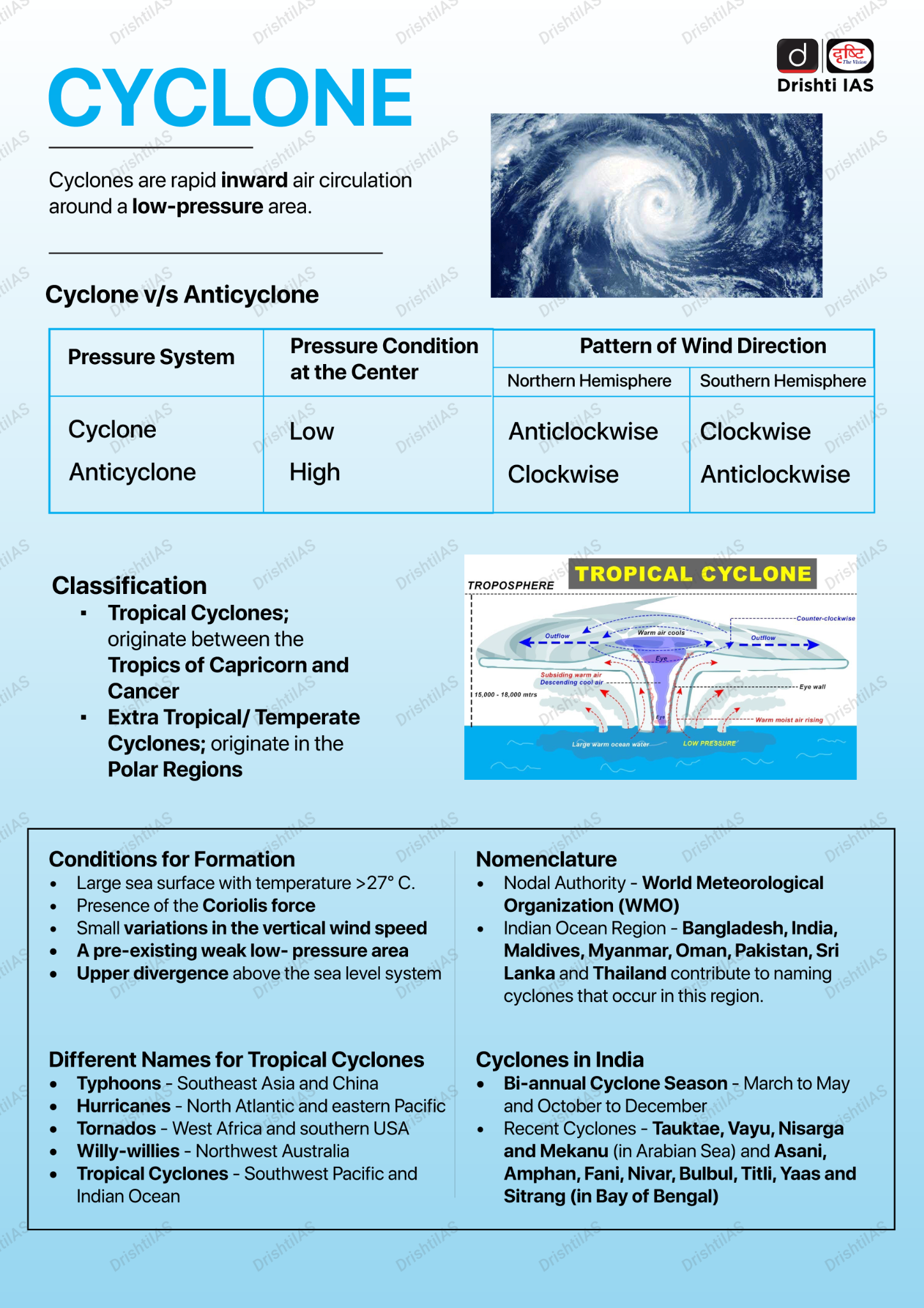Geography
Uncommon Cyclones in the Arabian Sea
- 10 Sep 2024
- 7 min read
For Prelims: Arabian Sea, Asna, Cyclone, El Niño, Southern Ocean
For Mains: Important Geophysical phenomena, Climate Change and its impact on Cyclone Dynamics
Why in News?
Recently, the Arabian Sea witnessed a rare August cyclone, named Asna, which stirred considerable interest due to its unusual timing and origin.
- The north Indian Ocean, which includes the Arabian Sea and the Bay of Bengal, is typically less active in terms of cyclones compared to global oceanic regions. However, Asna's emergence has brought attention to the growing influence of climate change on cyclogenesis in this region.
Note
Cyclogenesis refers to the development or strengthening of cyclonic circulation in the atmosphere, often leading to the formation of cyclones and associated weather phenomena.
What are the Factors Contributing to Cyclogenesis in the North Indian Ocean?
- Oceanic Tunnels: The Indian Ocean has unique oceanic tunnels connecting it to the Pacific and Southern Oceans.
- The Pacific Tunnel (Indonesian Throughflow) introduces warm water to the upper 500 meters of the Indian Ocean, contributing to higher sea surface temperatures (SSTs) in the Arabian Sea, potentially enhancing convection and moisture availability.
- Warm SSTs can provide energy for cyclone development, but the impact may be moderated by other factors.
- The Southern Ocean Tunnel brings cooler waters below 1 kilometer depth, which can stabilise the lower ocean layers and limit vertical mixing of warmer surface waters.
- The cooler waters may also reduce SSTs and limit the energy available for cyclone formation, potentially suppressing cyclonic activity.
- The Pacific Tunnel (Indonesian Throughflow) introduces warm water to the upper 500 meters of the Indian Ocean, contributing to higher sea surface temperatures (SSTs) in the Arabian Sea, potentially enhancing convection and moisture availability.
- Pre and Post-Monsoon Cyclones: The north Indian Ocean, encompassing the Arabian Sea and the Bay of Bengal, experiences two distinct cyclone seasons, pre-monsoon (April to June) and post-monsoon (October to December) unlike other regions that typically have one.
- The region's unique climatic and oceanographic conditions, including the monsoonal circulation and dramatic seasonal wind reversals, contribute to these dual cyclone seasons.
- During the pre-monsoon season, cyclogenesis can occur in both the Arabian Sea and the Bay of Bengal due to warming and increased convection.
- In the post-monsoon season (October-December), the northeast monsoon and dry continental air ends up cooling the Arabian Sea, reducing the likelihood of cyclone formation, while the Bay of Bengal remains more favourable for cyclones.
- However, the Climate change is altering the patterns and intensity of cyclones in the Indian Ocean.
Note
The Arabian Sea has fewer cyclones than the Bay of Bengal due to stronger vertical wind shear and less convective activity.
- Despite rapid warming before the monsoon, cooling during the monsoon and persistent cooler temperatures reduce cyclonic development.
- Recent warming trends affect both regions, but the Arabian Sea remains less active.
How does Climate Change Impact the Indian Ocean?
- Rapid Warming: Climate change is causing the Indian Ocean to warm rapidly. Increased heat from the Pacific Ocean and warmer waters pushed in from the Southern Ocean contribute to this trend.
- Changes in atmospheric winds and humidity, driven by global climate shifts, further intensify the warming of the Indian Ocean.
- Global Influence: The Ocean's rapid warming is affecting the heat uptake by the Pacific Ocean and the sinking of heavy waters in the north Atlantic Ocean.
- The Indian Ocean is acting like a clearinghouse (modulates global climate variability and contributes to the overall heat balance) for ocean warming during climate change.
- Cyclogenesis Impact: The rapid warming and associated climate changes impact cyclone formation, frequency, and behavior, highlighting the region's unique response to global warming.
Cyclone Asna
- Cyclone Asna, a rare August cyclone, has drawn significant attention as the first North Indian Ocean cyclone in August since 1981.
- The name Asna, which means “the one to be acknowledged or praised”, has been given by Pakistan.
- Cyclone Asna originated from a powerful land-based low-pressure system, which is typical as most such systems form over the Bay of Bengal and bring heavy monsoon rains to India.
- The system transitioned into a cyclone upon moving into the warm Arabian Sea, which was fueled by global warming and regional weather patterns, provided the necessary energy for Asna to intensify, but it eventually dissipated due to dry desert air entering the cyclone's circulation.
- Climate change is making cyclones in the Indian Ocean more unpredictable, with factors like global warming, El Niño, and underwater volcanic eruptions contributing to extreme weather events in India, where the monsoon season has become increasingly erratic with unpredictable rainfall patterns.
|
Drishti Mains Question: Q. Explain the factors contributing to cyclogenesis in the North Indian Ocean and the impact of climate change. |
UPSC Civil Services Examination Previous Year Question (PYQ)
Prelims
Q. Consider the following statements: (2020)
- Jet streams occur in the Northern Hemisphere only.
- Only some cyclones develop an eye.
- The temperature inside the eye of a cyclone is nearly 10ºC lesser than that of the surroundings.
Which of the statements given above is/are correct?
(a) 1 only
(b) 2 and 3 only
(c) 2 only
(d) 1 and 3 only
Ans: (c)
Q. In the South Atlantic and South-Eastern Pacific regions in tropical latitudes, cyclone does not originate. What is the reason? (2015)
(a) Sea surface temperatures are low
(b) Inter-Tropical Convergence Zone seldom occurs
(c) Coriolis force is too weak
(d) Absence of land in those regions
Ans: (b)
Mains:
Q. Tropical cyclones are largely confined to the South China Sea, Bay of Bengal and Gulf of Mexico. Why? (2014)








